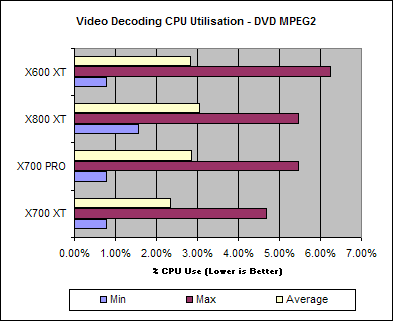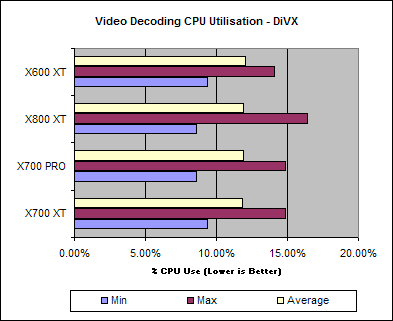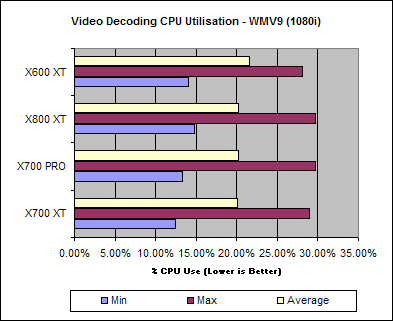Benchmarks - Video Decode CPU Usage
The X700’s are being pitched at as an all round board, useful for gaming as well as other functions such as video processing. Here we’ll take a look at the decode performance of the X700’s in comparison to the other Radeon’s we’ve been using in this test.
There has been a little confusion arisen as to how ATI processes video on their DirectX9 Radeon line as it is handled in multiple areas. Decoding and Encoding of video is a multi-stage process - without dedicated hardware the entirety of the processing can be achieved on the CPU, however for real-time encoding and decoding this can require a reasonably powerful CPU to achieve at high resolutions and high frame rates, hence the onus over the years has been to move more and more of the stages on to dedicated hardware to alleviate the CPU overhead required for high quality video processing (this can also have other knock-on benefits, such as lower heat produced and lower power requirements which can mean that a desktop PC will run cooler, hence quieter, or a laptop battery life can be extended whilst watching a DVD).
ATI have long since employed dedicated hardware for video processing within their PC graphics products which move some of the video processing stages from the CPU over to the graphics board, a couple of years back, though, ATI introduced “VideoShader” which runs some video processing over the programmable shader pipeline within the graphics chip. When ATI introduced VideoShader what, perhaps, wasn’t clear was that dedicated video processing elements where not removed as well, hence the video functions are split: the blocks of processing that are sensible to fit on the ALU instruction set and processing methodologies of the Pixel Shader pipeline will have shader programs written for them for processing over the shader pipeline (functions such as YUV colour space conversion), some functions will be processed on the dedicated video hardware within the graphics chip (such as motion compensation), whilst others will remain on the CPU. Note that whilst the desktop graphics chips can assist in video encoding as well as decoding, ATI’s current philosophy for serious, consumer electronics quality, encoding, with low CPU utilisation, is that this should be handled by a dedicated processor such as Theather 550 PRO, and the graphics processor should be seen as a decode acceleration device.
What we are measuring here is how much CPU usage various types of video processing takes up – the more functionality the graphics chip is able to handle, the lower the CPU utilisation per frame. Note that we are not including the Radeon 9800 PRO in these tests as this is on a different platform to the rest of the PCI Express boards – some stages of processing are still handled by the CPU and AMD and Intel platforms have very different video handling properties, hence in this case it would not be a like for like comparison.

| DVD MPEG2 (% CPU Usage) | Min | Max | Average |
| X700 XT | 0.78% | 4.69% | 2.34% |
| X700 PRO | 0.78% | 5.47% | 2.86% |
| X800 XT | 1.56% | 5.47% | 3.05% |
| X600 XT | 0.78% | 6.25% | 2.83% |
MPEG2 DVD playback doesn't really seem to stress a system these days, with probably the majority of processing being achieved on the graphics processor, to the extent that the CPU utilisation is peaking at only about 6% here. All the boards are in roughly the same ballpark in terms of CPU utilisation, with the X700 XT showing the lowest average CPU utilisation, by a small margin, and the X800 XT the highest, again by a small margin.

| DiVX (% CPU Usage) | Min | Max | Average |
| X700 XT | 9.38% | 14.84% | 11.85% |
| X700 PRO | 8.59% | 14.84% | 11.91% |
| X800 XT | 8.59% | 16.41% | 11.87% |
| X600 XT | 9.38% | 14.06% | 12.01% |
DiVX shows a higher CPU utilisation than MPEG2 did, this time averaging around the 12% mark on these Radeons. In this instance the X700 XT is still showing itself to have the lowest average CPU utilisation, whilst the X600 XT the highest.

| WMV8 - 1080i (% CPU Usage) | Min | Max | Average |
| X700 XT | 12.50% | 28.91% | 20.13% |
| X700 PRO | 13.28% | 29.69% | 20.20% |
| X800 XT | 14.84% | 29.69% | 20.20% |
| X600 XT | 14.06% | 28.13% | 21.58% |
The WMV9 format is placing the most stress on the CPU out of the three test, which should come as no surprise as it it the highest resolution format. The average CPU utilisations for all the Radeons here is around the low 20's, with the lowest average still staying with the X700 XT, whilst the highest again falling to the X600 XT.
Overall the performance for all the the four Radeon's here are very close and the video engine appears to be very close, if not exactly the same, between them all. We are using boards with varying numbers of shader pipelines and clock speeds, and it looks as though the elements that are processed via "VideoShader" are not varying with the 3D performance of the boards.
